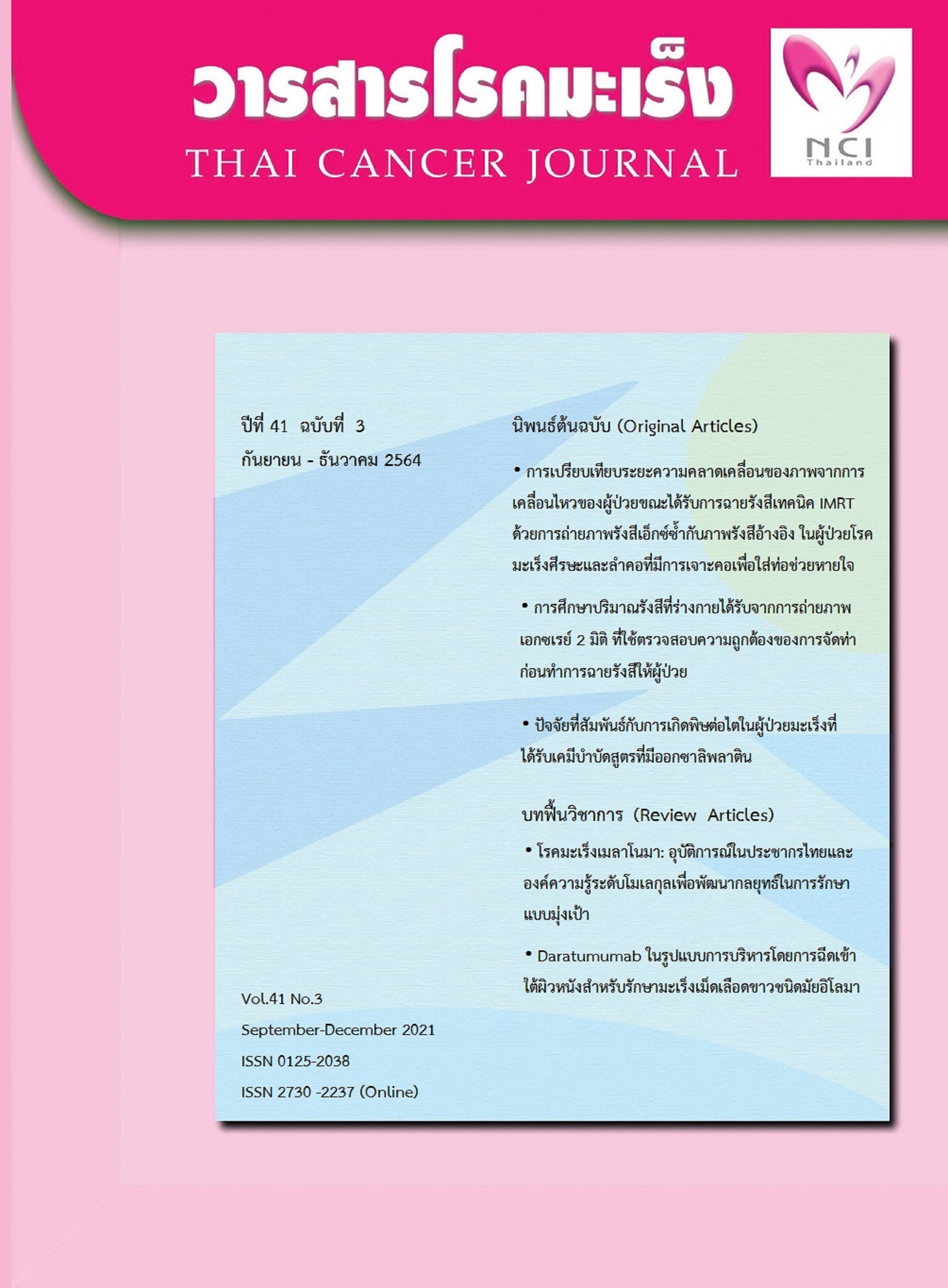A comparison of intra-fraction motion during IMRT treatment between on-board imaging radiograph and reference X-ray image in head and neck cancer patients with tracheostomies
Keywords:
การรักษาด้วยรังสีโดยเทคนิคแบบปรับความเข้ม, การฉายรังสีเทคนิค IMRT, ภาพรังสีเอกซ์, มะเร็งศีรษะและลำคอ, การเจาะคอเพื่อใส่ท่อช่วยหายใจAbstract
Head and neck cancer is the top ten death in Thailand and is challenging to treat by Intensity Modulated Radiation Therapy (IMRT). So the accuracy and precision for IMRT treatment in a patient with a tracheostomy who may cough during treatment are critical. Objectives: To compare image deviation from motion during IMRT treatment between on-board imaging radiograph and reference X-ray image in patients. Methods: A quasi-experimental research comparing image deviation from motion during IMRT treatment between on-board imaging radiograph (OBI) and reference X-ray image in a patient with tracheostomy. The sample was 95 head and neck cancer patients with tracheostomies who received radiation treatment in the Radiotherapy Department, Lopburi Cancer Hospital. The research tool was an on-board imaging device on the Linear accelerator machine series Clinic ix. The data record form includes regular patient information and image deviation from motion during treatment between on-board imaging radiograph and reference X-ray image. Data acquisition was recorded by the image deviation from motion during IMRT treatment between on-board imaging radiograph and reference X-ray image which is displayed on the monitor of portal imaging program. The data acquisition period was between 1st March 2020 and 31st October 2020. The data were analyzed using Wilcoxon Sign Rank Test statistics. Results: The results found that 69.5 percent of patients were male and aged between 40-60 years old.There were 81 percent and 87 percent had a cough and hard to breathe, so the image deviation value of the X-ray image missed align from the reference image in all axis with the P-value were 0.444, 0.705 and 0.423 in x, y, z-axis by order. Conclusions: Finally, the image deviation value of X-ray image in head and neck cancer patients with tracheostomies is not statistically different. So, the use of IMRT treatment technique is practical in patients with tracheostomies.
References
Rattanawichitrasin A. Siriraj Cancer Registry 2008. Bangkok, Thailand: Siriraj Cancer Center 2008.
Lopburi Cancer Registry.(2018). Patient registry information in 2020.[cited 2020 July 8] Available from: https://www.lopburicancenter.n.th/index.php/sick1-2/hos8/2561
Kam MK, Leung SF, Zee B, et al. Prospective Randomized study of intensity-modulated radiotherapy on salivary gland function in early stage nasopharyngeal carcinoma patients. J Clin Oncol. 2007;25:4873-9.
Peters LJ, Goepfert H, Ang KK, Byers RM, Maor MH, Guillamondegui O, et al. Evaluation of the dose for postoperative radiation therapy of head and neck cancer: first report of a prospective randomized trial. Int J Radiat Oncol Biol Phys. 1993;26:3-11.
Nutting C.M, Morden J.P, Harrington KJ,Urbano G. T, Bhide A.S, Clark C, et al. Parotid-sparing intensity modulated versus conventional radio therapy in head and neck cancer (PARSPORT): a phase 3 multicentre randomised controlled trial. Lancet Oncol 2011;12:127-36.
Taweeboon N, Natukanon K, Techawongsuwan S. Comparison of setup error of isocenter between above and below nipple levels in thoracic and upper abdominal malignancies using KV orthogonal or Cone-beam computed tomography (CBCT) images at Siriraj Hospital. J Thai Assn of Radiat Oncol. 2018 Jun 28;24:25-34.
ลัดดา เย็นศรี. การศึกษาเปรียบเทียบปริมาณรังสีที่ผู้ป่วยได้รับจากการถ่ายภาพรังสีทรวงอกด้วยระบบ CR และ DR. วารสารเครือข่ายวิทยาลัยพยาบาลและการสาธารณสุขภาคใต้. 2559; 3: 129-39.
Downloads
Published
Issue
Section
License
บทความทีตีพิมพ์ในวารสารโรคมะเร็งนี้ถือว่าเป็นลิขสิทธิ์ของมูลนิธิสถาบันมะเร็งแห่งชาติ และผลงานวิชาการหรือวิจัยของคณะผู้เขียน ไม่ใช่ความคิดเห็นของบรรณาธิการหรือผู้จัดทํา







